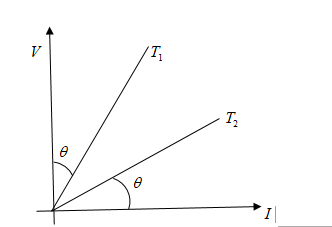
graph \[V - I\] of a conductor at two different temperatures is shown in fig. the ratio of temperature $\dfrac{{{T_1}}}{{{T_2}}}$ is:
(A) ${\tan ^2}\theta $
B) ${\cot ^2}\theta $
C) ${\sec ^2}\theta $
D) $\cos e{c^2}\theta $


Answer
143.4k+ views
Hint As we can see in the figure that $V$ and $I$ are making a right angle triangle, and ${T_1}$ is making angle $\theta $ with voltage and similarly ${T_2}$ is making $\theta $ angle with current. So, we apply trigonometry functions to solve this problem.
Complete Step by step solution
As per figure, we can see that
${T_1} = \tan \theta $
And ${T_2} = \tan \left( {90 - \theta } \right)$
We know that the value of $\tan \left( {90 - \theta } \right)$will become $\cot \theta $
Now, we can say that ${T_2} = \cot \theta $
To find out the ratio of $\dfrac{{{T_1}}}{{{T_2}}}......(1)$
We will put the values of ${T_1}$ and ${T_2}$in equation $(1)$
$\dfrac{{{T_1}}}{{{T_2}}} = \dfrac{{\tan \theta }}{{\cot \theta }}......(2)$
We know that $\cot \theta = \dfrac{1}{{\tan \theta }}$, we put it equation $(2)$
$\dfrac{{{T_1}}}{{{T_2}}} = {\tan ^2}\theta $
Hence, option a is the right answer
Note We should keep in mind trigonometry formulas to solve this problem. As we know that $90 - \theta $means value will lies in first quadrant and in first quadrant $\tan \theta $ will convert in $\cot \theta $, so the value of $\tan \left( {90 - \theta } \right)$ will become $\cot \theta $
Additional information $V - I$ graph stands for a graph of voltage and current, and it shows us properties of a conductor or device. $V - I$ Graph tells valuable information about the resistance in the circuit and breakdown of the electronic component. This information helps us place the electronic component in an electronic circuit. Voltage lies on $y - axis$ and current lies on $x - axis$, resistance tells us the type of the graph. If resistance is constant, the graph will be linear and if resistance is not constant means variable then the graph will be non-linear.
There are different types of $V - I$ graphs, which are as below:
Linear $V - I$ graph
Non-linear $V - I$ graph
$V - I$ Characteristics of SCR
$V - I$ Characteristics of LED
$V - I$ Characteristics of MOSFET
$V - I$ Characteristics of PN Junction Diode
$V - I$ Characteristics of Zener Diode
Complete Step by step solution
As per figure, we can see that
${T_1} = \tan \theta $
And ${T_2} = \tan \left( {90 - \theta } \right)$
We know that the value of $\tan \left( {90 - \theta } \right)$will become $\cot \theta $
Now, we can say that ${T_2} = \cot \theta $
To find out the ratio of $\dfrac{{{T_1}}}{{{T_2}}}......(1)$
We will put the values of ${T_1}$ and ${T_2}$in equation $(1)$
$\dfrac{{{T_1}}}{{{T_2}}} = \dfrac{{\tan \theta }}{{\cot \theta }}......(2)$
We know that $\cot \theta = \dfrac{1}{{\tan \theta }}$, we put it equation $(2)$
$\dfrac{{{T_1}}}{{{T_2}}} = {\tan ^2}\theta $
Hence, option a is the right answer
Note We should keep in mind trigonometry formulas to solve this problem. As we know that $90 - \theta $means value will lies in first quadrant and in first quadrant $\tan \theta $ will convert in $\cot \theta $, so the value of $\tan \left( {90 - \theta } \right)$ will become $\cot \theta $
Additional information $V - I$ graph stands for a graph of voltage and current, and it shows us properties of a conductor or device. $V - I$ Graph tells valuable information about the resistance in the circuit and breakdown of the electronic component. This information helps us place the electronic component in an electronic circuit. Voltage lies on $y - axis$ and current lies on $x - axis$, resistance tells us the type of the graph. If resistance is constant, the graph will be linear and if resistance is not constant means variable then the graph will be non-linear.
There are different types of $V - I$ graphs, which are as below:
Linear $V - I$ graph
Non-linear $V - I$ graph
$V - I$ Characteristics of SCR
$V - I$ Characteristics of LED
$V - I$ Characteristics of MOSFET
$V - I$ Characteristics of PN Junction Diode
$V - I$ Characteristics of Zener Diode
Recently Updated Pages
How to find Oxidation Number - Important Concepts for JEE

How Electromagnetic Waves are Formed - Important Concepts for JEE

Electrical Resistance - Important Concepts and Tips for JEE

Average Atomic Mass - Important Concepts and Tips for JEE

Chemical Equation - Important Concepts and Tips for JEE

Concept of CP and CV of Gas - Important Concepts and Tips for JEE

Trending doubts
JEE Main 2025 Session 2: Application Form (Out), Exam Dates (Released), Eligibility, & More

JEE Main Exam Marking Scheme: Detailed Breakdown of Marks and Negative Marking

JEE Main 2025: Derivation of Equation of Trajectory in Physics

Electric Field Due to Uniformly Charged Ring for JEE Main 2025 - Formula and Derivation

Degree of Dissociation and Its Formula With Solved Example for JEE

Physics Average Value and RMS Value JEE Main 2025

Other Pages
Units and Measurements Class 11 Notes: CBSE Physics Chapter 1

JEE Advanced Marks vs Ranks 2025: Understanding Category-wise Qualifying Marks and Previous Year Cut-offs

NCERT Solutions for Class 11 Physics Chapter 1 Units and Measurements

JEE Advanced 2025: Dates, Registration, Syllabus, Eligibility Criteria and More

Motion in a Straight Line Class 11 Notes: CBSE Physics Chapter 2

JEE Advanced Weightage 2025 Chapter-Wise for Physics, Maths and Chemistry




